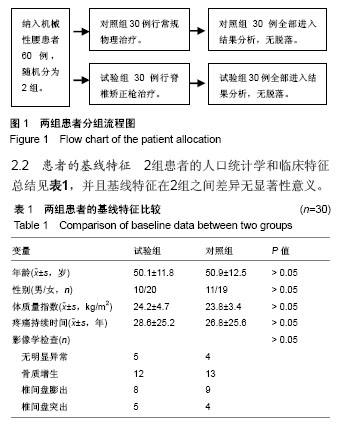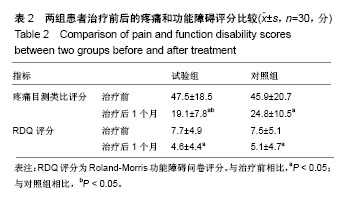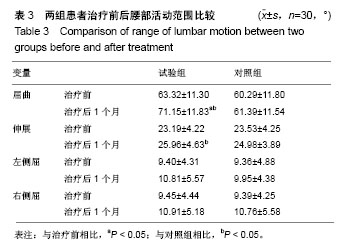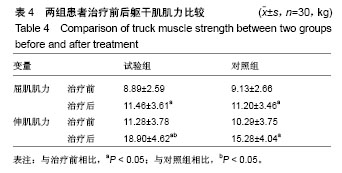中国组织工程研究 ›› 2018, Vol. 22 ›› Issue (35): 5637-5641.doi: 10.3969/j.issn.2095-4344.1009
• 骨与关节生物力学 bone and joint biomechanics • 上一篇 下一篇
机械脉冲力脊椎矫正与常规理疗治疗机械性腰痛:腰部活动范围和躯干肌肌力的比较
朱中亮1,俞晓杰2,刘邦忠3,朱 民1,赵莉亚1,闫冬冬1
- 1上海市青浦区朱家角人民医院康复科,上海市 201713;2上海交通大学医学院附属仁济医院南院疼痛科,上海市 201112;3复旦大学附属中山医院康复医学科,上海市 200031
Spinal mechanical impulsive manipulation versus conventional physiotherapy for chronic low back pain: differences in range of lumbar motion and trunk muscle strength
Zhu Zhongliang1, Yu Xiaojie2, Liu Bangzhong3, Zhu Min1, Zhao Liya1, Yan Dongdong1
- 1Department of Rehabilitation, Zhujiajiao People’s Hospital of Qingpu District, Shanghai 201713, China; 2Department of Pain, South Branch of Renji Hospital, Shanghai Jiao Tong University School of Medicine, Shanghai 201112, China; 3Department of Rehabilitation Medicine, Zhongshan Hospital of Fudan University, Shanghai 200031, China
摘要:
文章快速阅读:
.jpg)
文题释义:
脊椎矫正:或称为整脊术,给特定椎体传递一个动态冲力,即高速低幅手法。
机械性腰痛:指定义为疼痛来源于脊柱或骨盆及其周围的支持结构,但是难以进行精确的解剖学定位,疼痛能够通过腰背部运动或诱发试验重现。
摘要
背景:研究发现机械性腰痛与某些姿势、肌肉和活动度特性有关。与病源学因素有关的情况包括腰椎前凸下降或过度、腹肌肌力下降、躯干屈肌和伸肌肌力失衡、腰部活动度下降等,而脊椎矫正,或称为整脊术是国外作为脊柱功能障碍和疼痛的一种保守治疗方法。
目的:评价机械脉冲力脊椎矫正和常规物理因子治疗对于机械性腰痛患者主观疼痛和功能障碍指标以及腰部活动范围和躯干肌肌力的影响。
方法:采用随机对照前瞻性临床研究方法,入选60例年龄18-65岁、病程在6周以上、伴有或不伴有下肢放射痛的机械性腰痛患者,随机分配到试验组(机械脉冲力脊椎矫正)和对照组(常规物理因子治疗)。2组治疗均为每周2次,共4周。在治疗前和治疗后1个月评估患者的目测类比评分、Roland-Morris功能障碍问卷评分、腰部活动范围和躯干肌肌力。
结果与结论:①与治疗前相比,2组腰痛患者在治疗后1个月的疼痛和功能障碍均显著下降(P < 0.05),试验组治疗后1个月目测类比评分显著低于对照组(P < 0.05);②与治疗前相比,试验组治疗后1个月显示屈曲和伸展活动范围均显著改善(P < 0.05);治疗后1个月试验组腰部屈曲活动范围优于对照组(P < 0.05);③与治疗前相比,2组患者治疗后的躯干屈肌和伸肌肌力均有显著改善(P < 0.05);治疗后1个月试验组的躯干伸肌肌力改善优于对照组(P < 0.05);④提示相比于常规物理因子治疗,机械脉冲力脊椎矫正法治疗机械性腰痛在缓解疼痛以及改善腰部活动范围和躯干肌肌力方面更加有效。
中国组织工程研究杂志出版内容重点:人工关节;骨植入物;脊柱;骨折;内固定;数字化骨科;组织工程
ORCID: 0000-0003-0002-7716(朱中亮)
中图分类号:




.jpg)